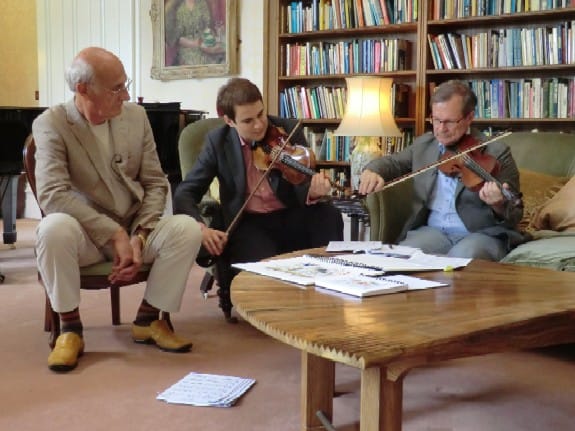
Jack and Brian (centre and right) attempt Edward’s composition
By James Dacey
Over the centuries, the deep connections between physics and music have been noted by many, particularly in the way both endeavours are underpinned by a mathematical language.
In a new collaboration, the two activities are about to meet head on with the internationally renowned composer Edward Cowie teaming up with particle physicist Brian Foster and the violinist Jack Liebeck. Cowie has been commissioned to produce a major new series of works for solo violin that will trace the history of particle physics from the late 19th century through to the present day. The plan is for Foster and Liebeck to perform the pieces at several major science facilities during the 2012/2013 season. The trio may also be releasing a commercial CD.
On Friday I went to meet the three collaborators at Oxford University where they were discussing the progress of this unique composition, entitled Particle Partitas. I was there with the Physics World multimedia team to record a short feature film about the project, which will be appearing on physicsworld.com within the next few weeks.
Cowie, who says he writes his music as an expression of the experiences he has living and moving in the natural landscape, in fact trained as a physicist. He studied the subject at Imperial College, London, while he was still learning the piano and violin in his spare time, as well as doing the odd performance. Unfortunately, Cowie had to stop playing the violin seriously after a sporting injury to his left hand in 1966. It was interesting to hear that Cowie had composed the whole of this latest work without an instrument.
It was also fascinating to hear about the depths of thought that have gone into the work and to see how Cowie’s understanding of particle physics has informed the music. For instance, he talked about how one section of the piece gradually divides into shorter and shorter musical expressions. This, he said, mirrors the way Democritus conceived the concept of an atom as the division of matter into a final indivisible particle.
After all of the discussions, Cowie then treated us to a rendition of one of his earlier works: Rutherford’s Lights – a set of 24 “studies in light and colour for piano”. (He still regularly performs on the piano.) You can hear part of this work and Cowie talking about its influences in this interview with my colleague Michael Banks from December last year. You can also see a few more pictures from Friday’s meeting in this photo set on Flickr.



